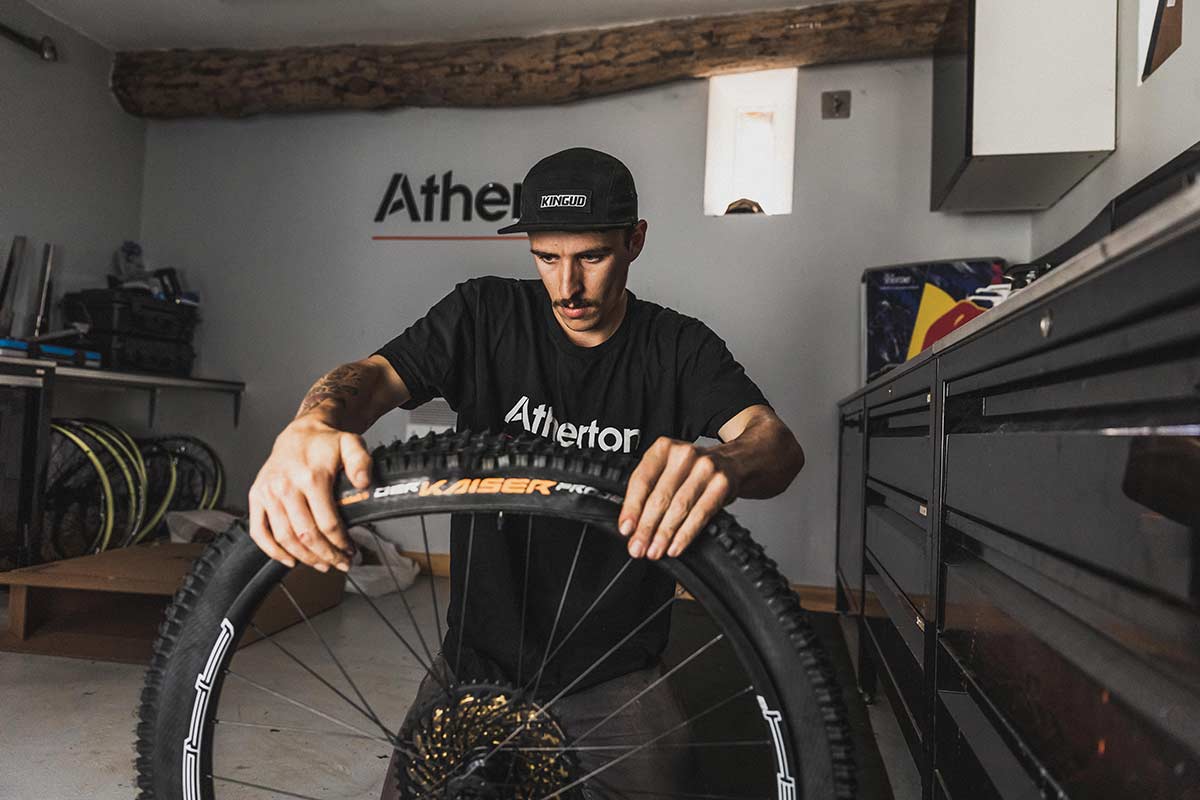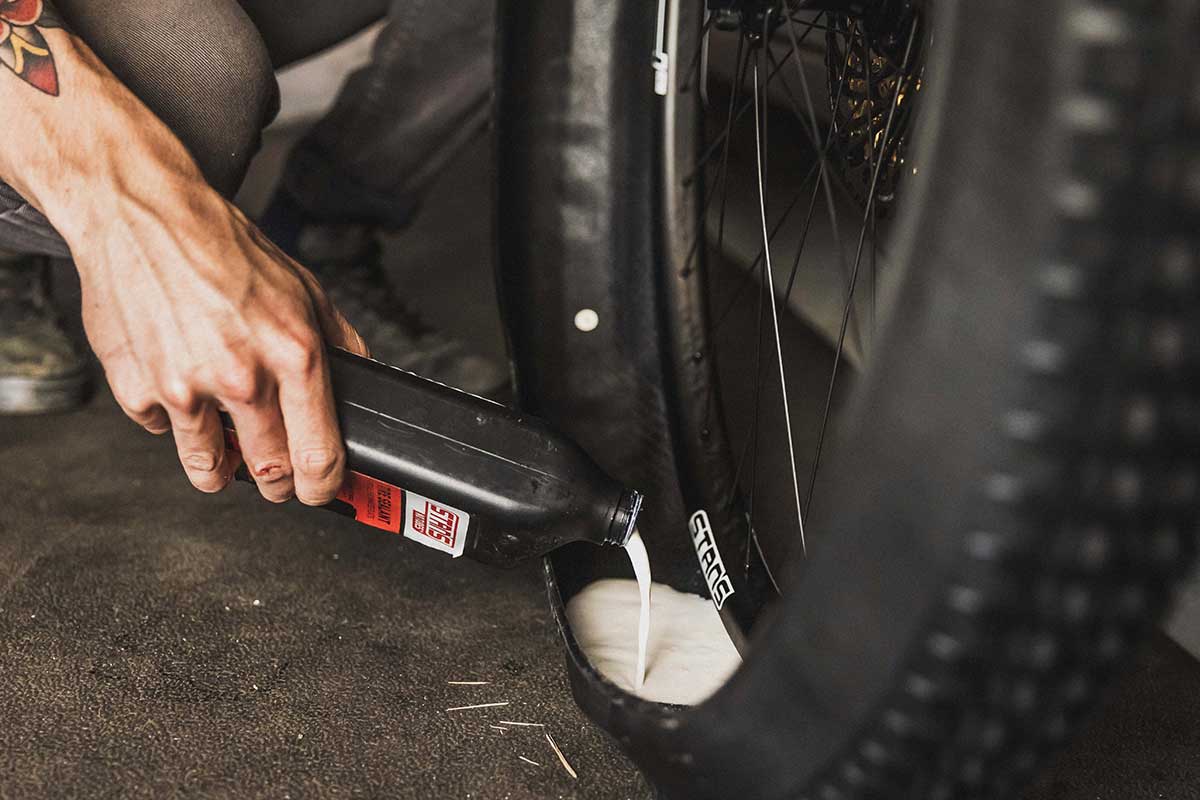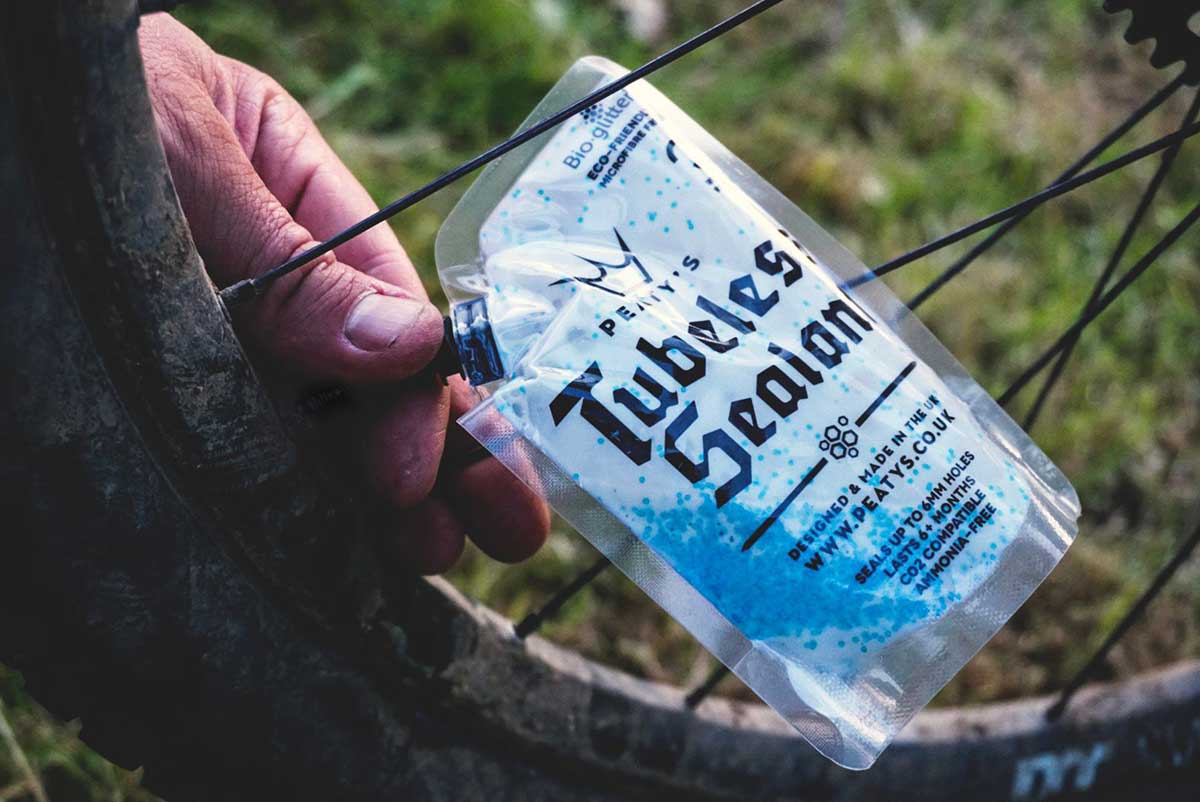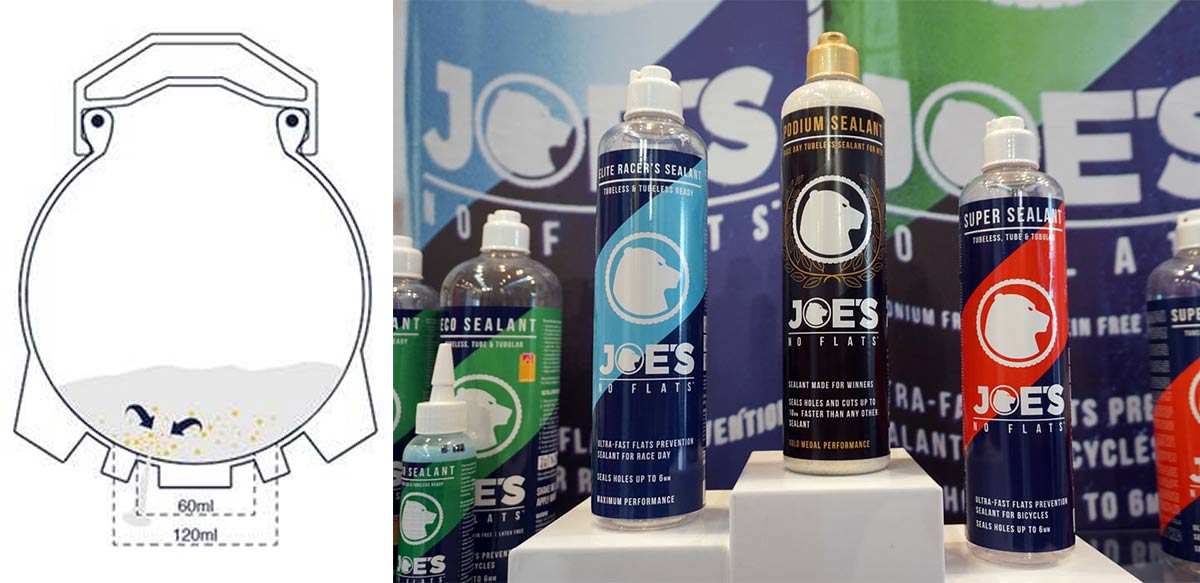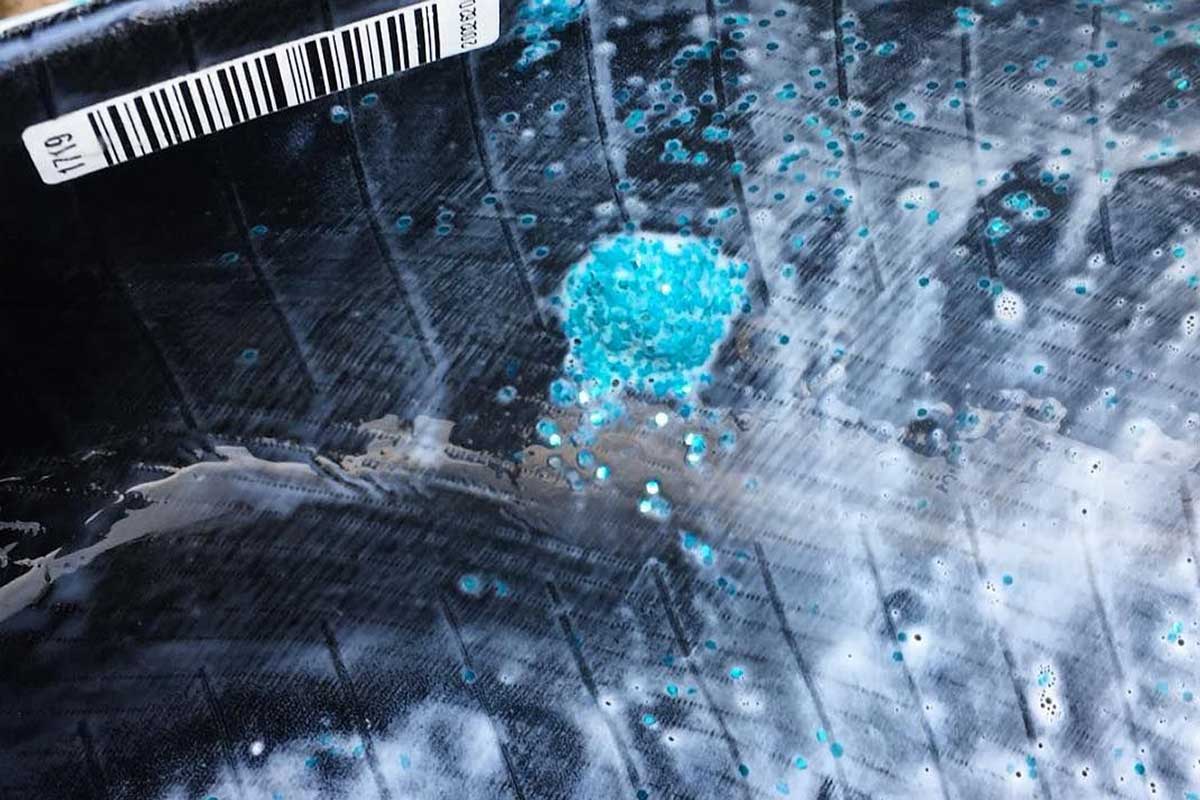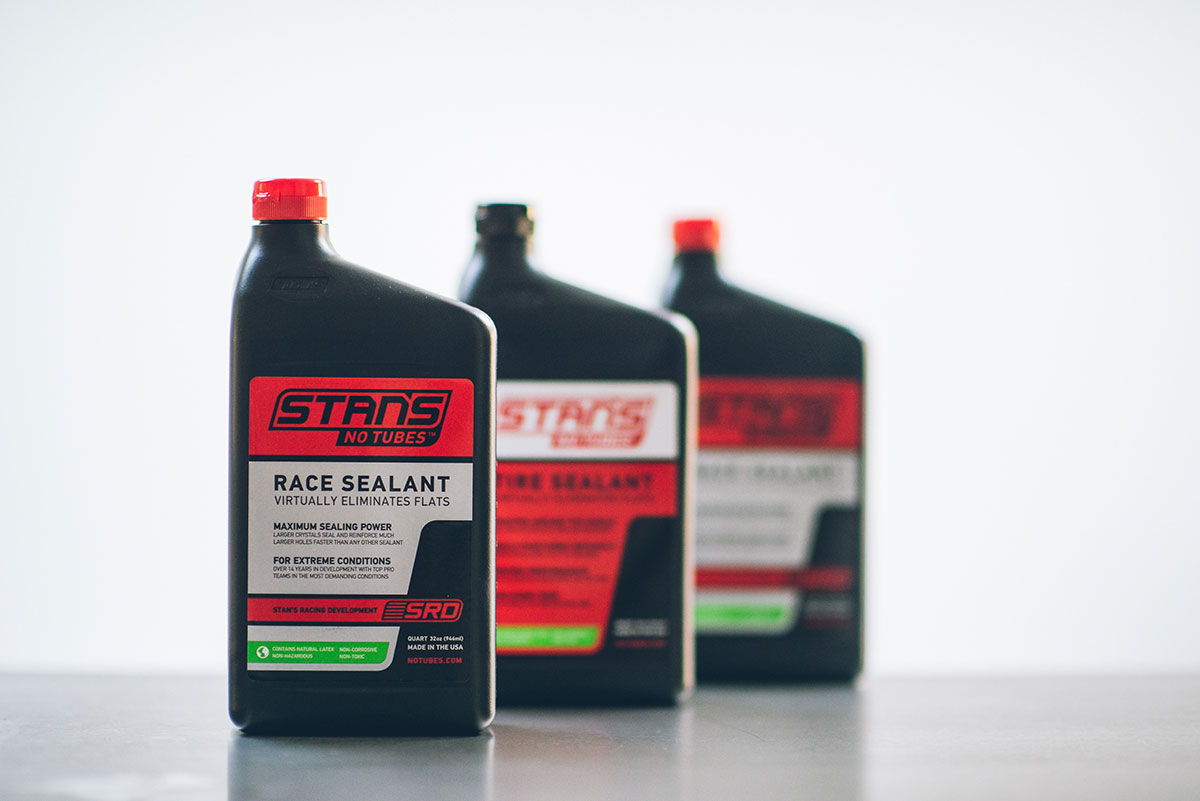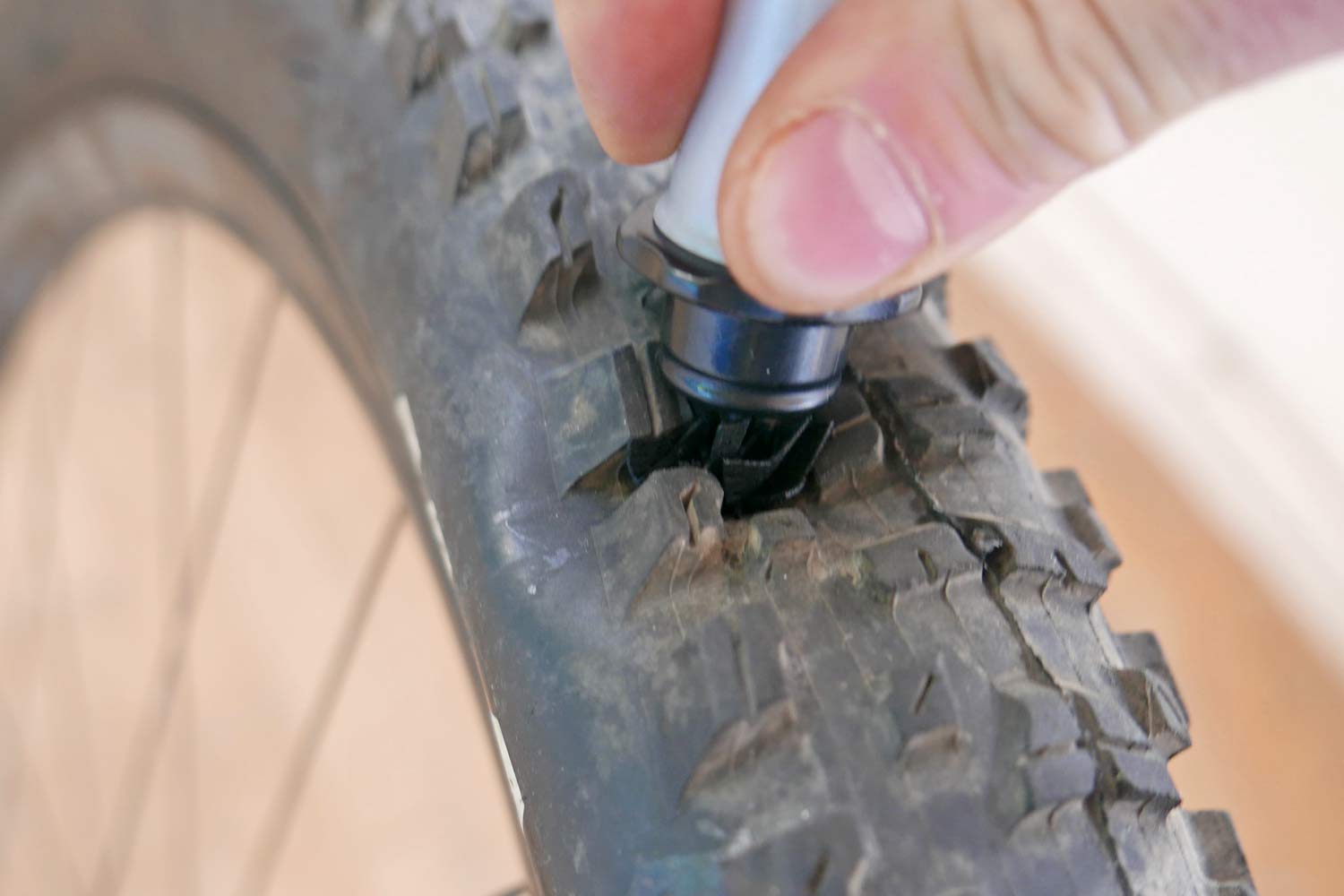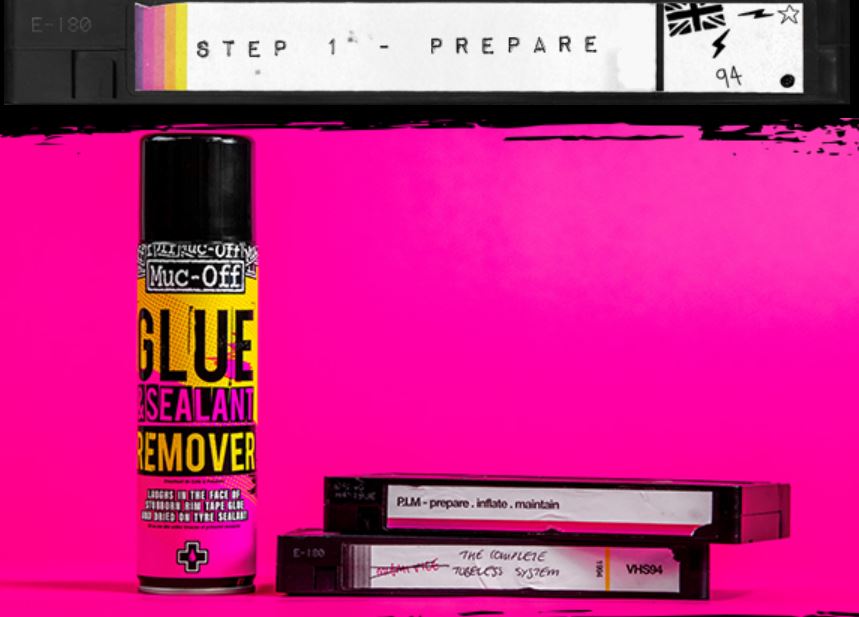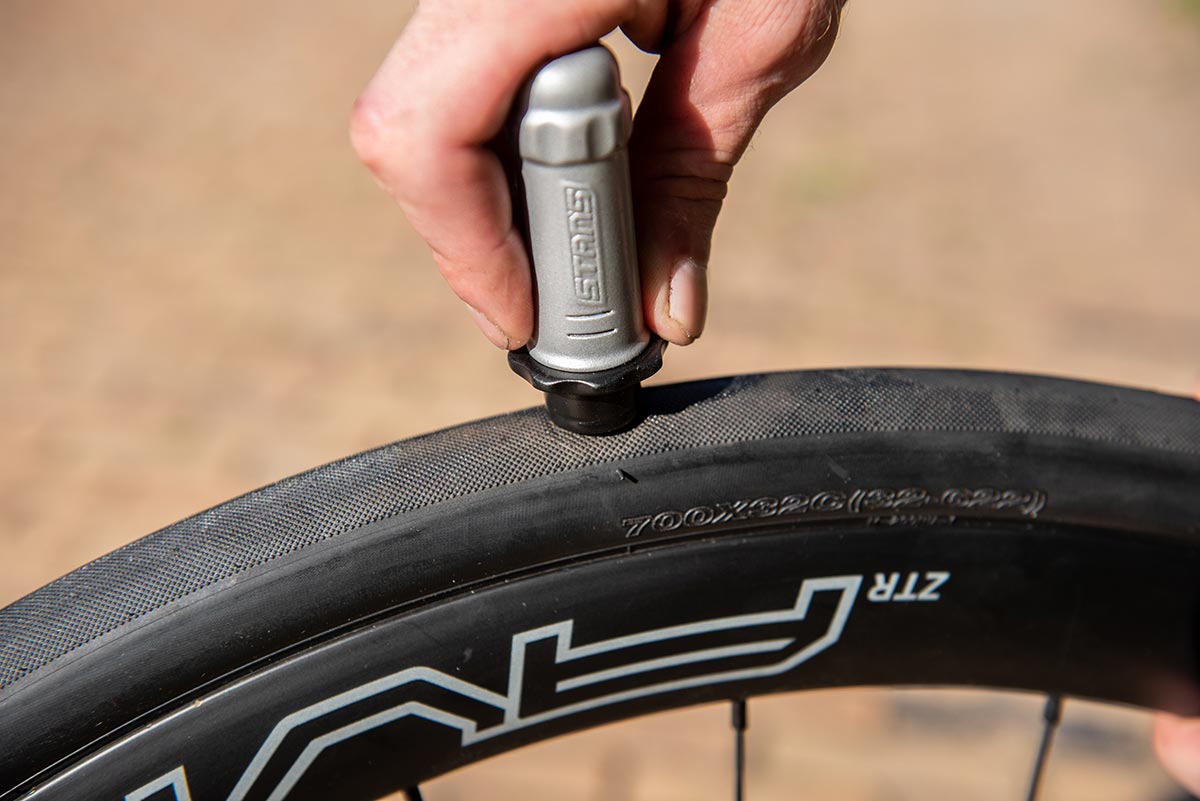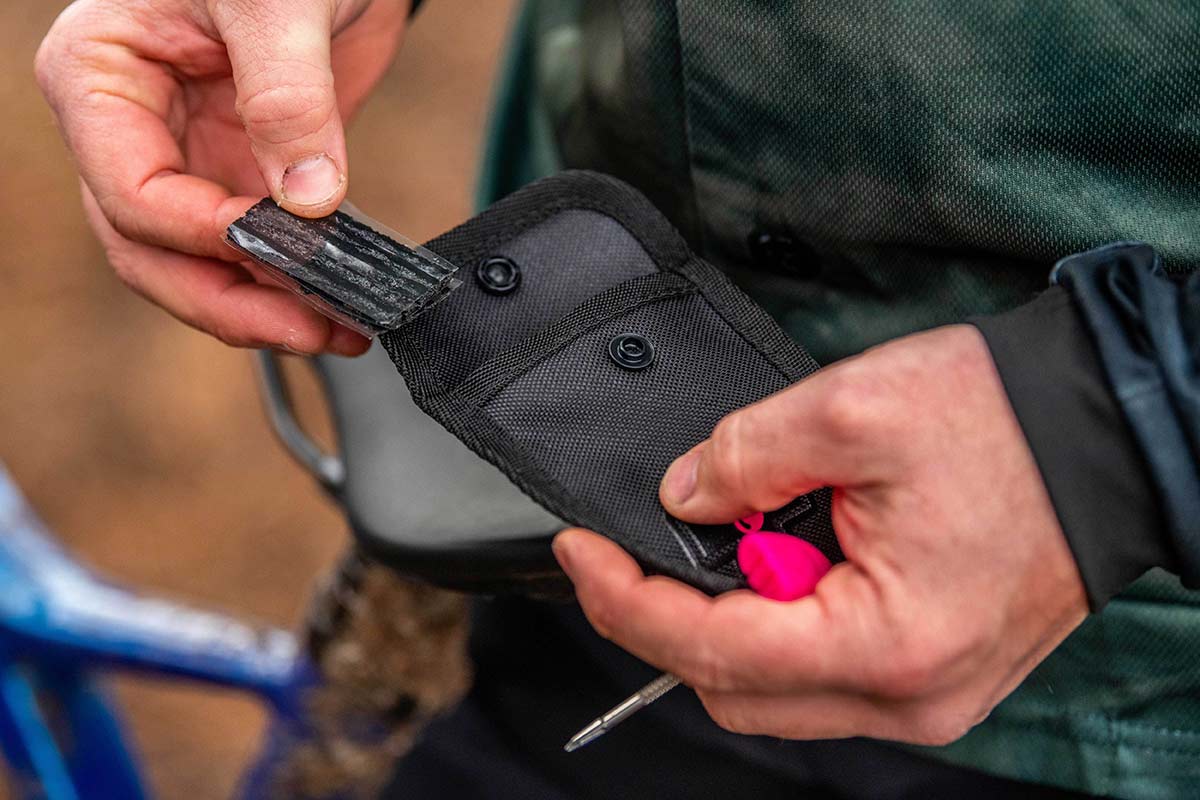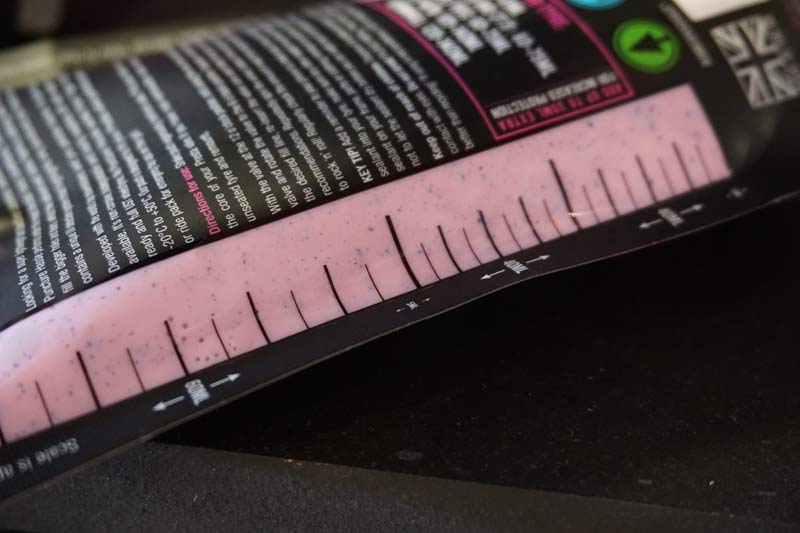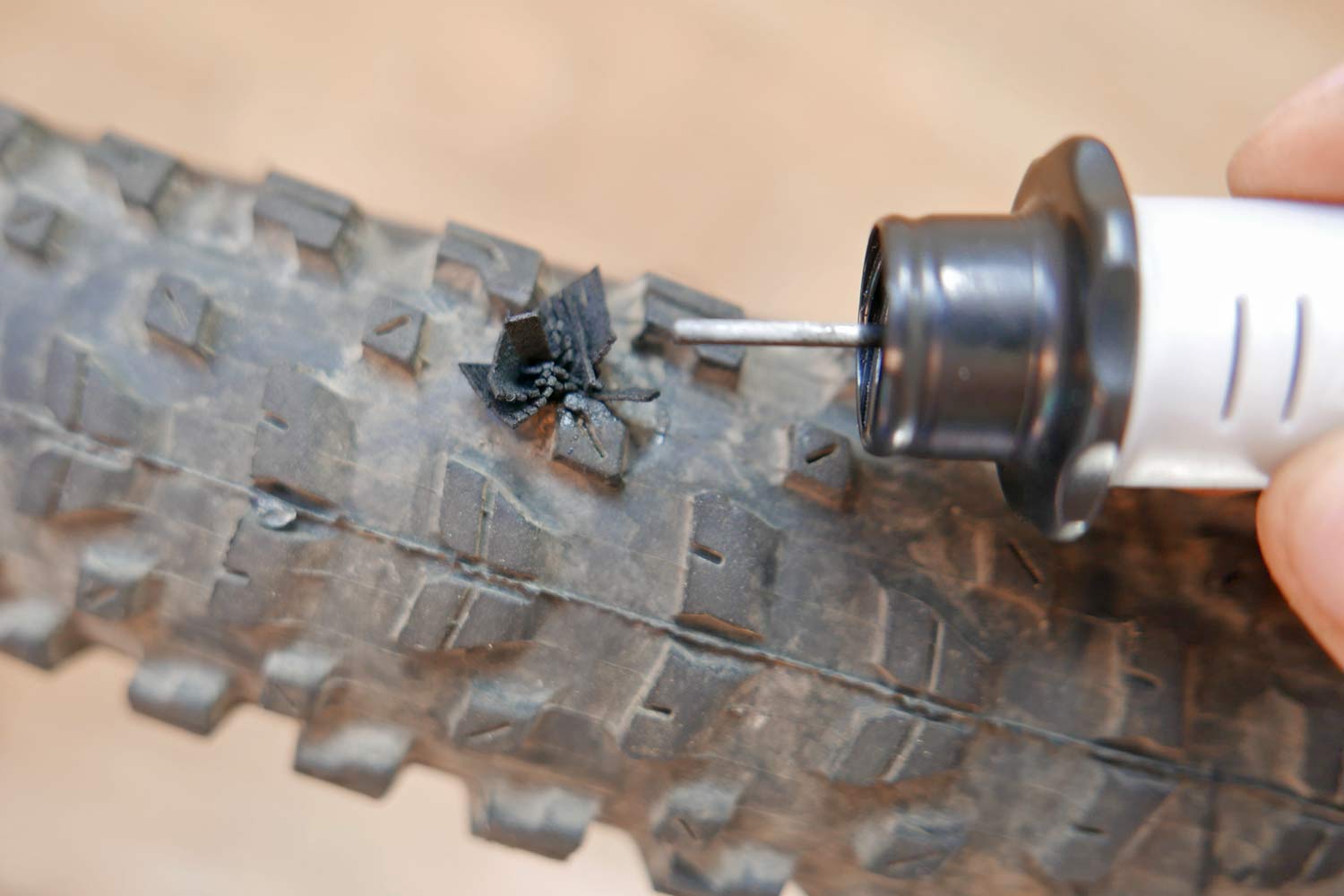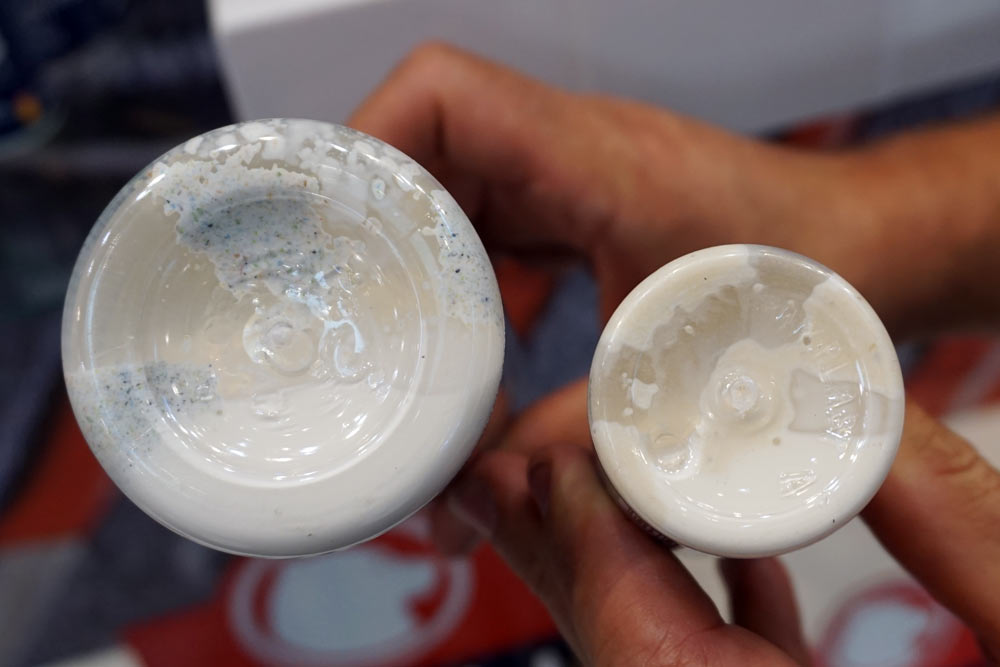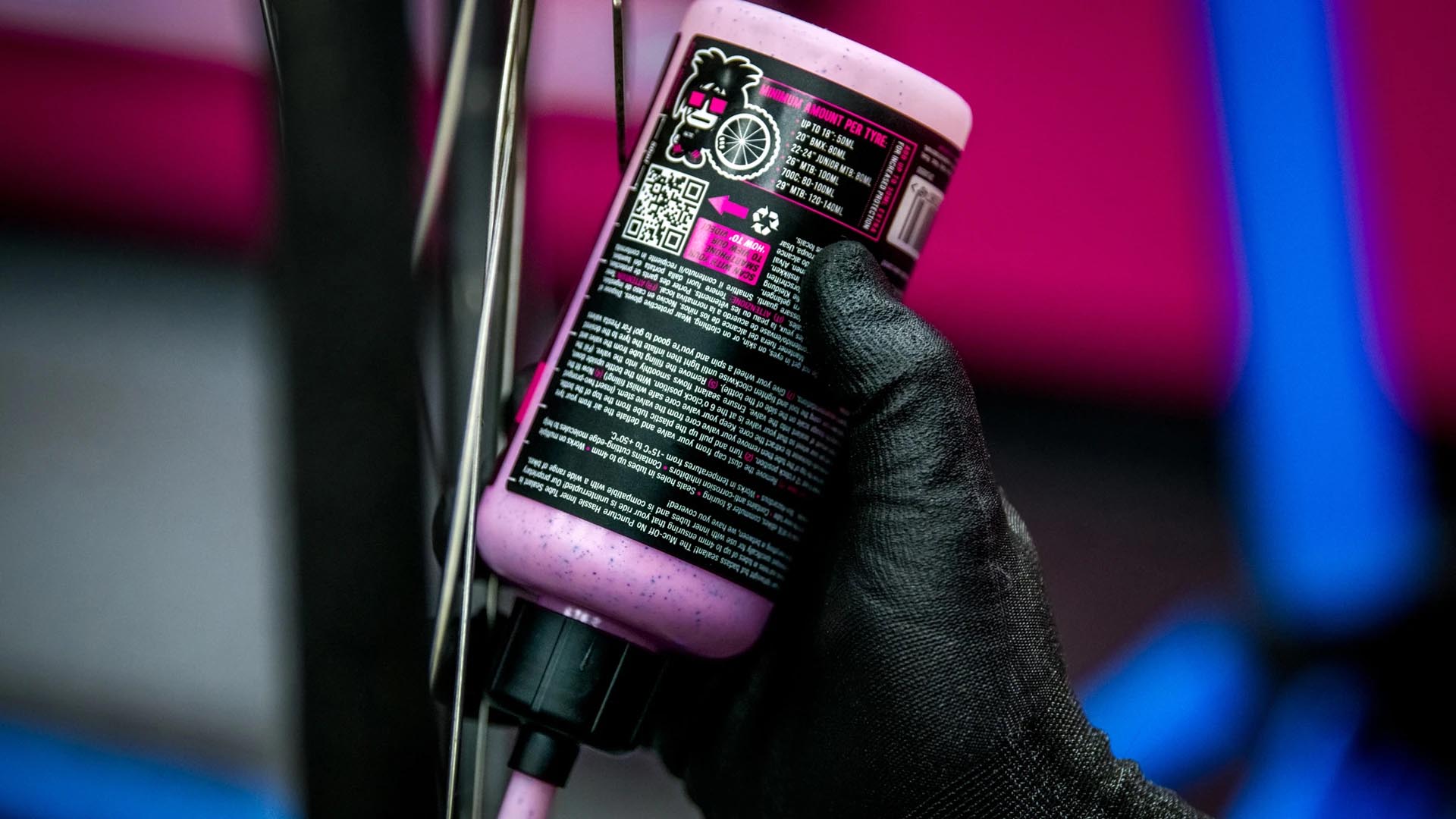We know, there’s no such thing as a stupid question. But there are some questions you might not want to ask your local shop or riding buddies. AASQ is our weekly series where we get to the bottom of your questions – serious or otherwise. This one covers tubeless sealant! Hit the link at the bottom of the post to submit your own question.
A tubeless tire setup is now the preferred option for many road and gravel cyclists and mountain bikers too. Initial setup can sometimes be messy, but the benefits are worth the perseverance.
For MTB at least, a tubeless setup means you may never even notice that small holes have appeared in your tire, as the tubeless sealant (usually) seals them so rapidly. And, it often means you can run lower tire pressures, and benefit from the improved traction that comes with it.
There are hundreds of tubeless sealant options on the market. Which sealant seals the largest holes? Which is the most environmentally friendly? How much do you need to use and how often do you need to top it up? All these questions and more are answered below by the experts at Joe’s No Flats, Peaty’s, Stan’s No Tubes and Muc-Off.
How much tubeless sealant is required for a 29″ x 2.4″ tire?
Stan’s No Tubes: That depends on whether or not the tire has already been set up tubeless or not. A new tire will always absorb a bit of sealant at the initial setup. This is the sealant filling in the imperfections in the casing of the tire.
For that reason we recommend more sealant. About 4oz for a new setup, and 2oz for a refresh after the tire has been set up initially.
Peaty’s: The short answer is 120ml for that size tyre.
The long answer is that how much sealant you should use is down to what sort of riding you’re planning on doing and how much puncture protection you want. For example, in some races (with very low/no puncture risk), the Canyon DHB road racing team only paint our sealant onto the rim and tire bead. They don’t run any residual sealant inside the tyre to save on weight. This gives them a tubeless seal but zero puncture protection.
The more sealant you add to float around inside the tire from that point will give you more puncture protection, but add more weight. 120ml is the most we tend to put in any size tire at one time (apart from fat bikes!) which is why we made our handy trail bag, toolbox or glovebox sized TrailPouch 120ml.
Joe’s No Flats: Liquid sealant runs freely inside the tire. When a puncture occurs, a small portion of the sealant is sucked into the hole and seals the puncture permanently. In order to ensure effective sealant protection, the sealant must reach any relevant part of the tire.
Using a smaller amount of sealant reduces weight but leaves you exposed to ineffective protection. The amount of sealant needed for your tire depends on tire size and riding/storage conditions.
We recommend using at least 125ml for 2.4″ tires. The drawing shows the difference in the tire’s protected area when using 60 ml versus 120ml of sealant per tire during the spin of the wheel.
Muc-Off: For a tire of this gnar-level we recommend using 140ml of our No Puncture Hassle Sealant but you can always add up to 30ml extra for #fullsend protection!
How often do I need to top-up or replace my tire sealant?
Stan’s No Tubes: That really depends on a number of different factors like climate, how the bike is stored, how often the bike is ridden, and how many sharp things are out in the trail trying to ruin your day.
Our bottle recommends a refresh interval of 2-7 months. We rely heavily on local bike shops to be the experts here for customers and recommend a refresh interval based on the climate and conditions in their local areas.
Basically, if you live somewhere hot and dry, you will be more towards the short end of the spectrum, cooler climates can wait a bit longer between refreshes.
Peaty’s: As a general rule, we say you should replace your sealant after six months in temperate climates, but in reality, we’ve had sealant last a lot longer than that. The best bet is to pop the bead off the tire every few weeks and check the sealant is still liquid and ensure you’ve still got a good amount of residual sealant pooled in the bottom of the tire.
If you’ve lost some sealant from a puncture, or over several months of evaporation, you can simply top up with some more fresh sealant and you’re good to go.
Joe’s No Flats: To maintain the correct amount of sealant in your tires, add a third of the original amount used for each tire periodically. In a cold climate add sealant every 3-6 months and in a hot climate every 2-4 months. Add sealant after each time you suffer a serious puncture on the trail.
Muc-Off: Check it every six months when using in temperate/mild climates and top up if required. If you live somewhere super scorcio (35°+) it’s best to check the tire every 3-4 months and top up as required.
What’s the best way to clean tubeless sealant off the inside of a mountain bike tire?
Stan’s No Tubes: The best way to clean out a tire with wet sealant is to rinse it out with water and wipe it with a dry rag or towel.
It’s especially important to rinse out the tire if you are using our Race Sealant. It can make the tire a bit “crunchy” if you don’t rinse it before putting it away. For dried sealant, it’s not necessary to clean much of it out, just focus on removing any large deposits and focus your efforts around the bead of the tire.
Just a dry rag or a brush will do the job. You don’t want to remove any small bits stuck to the tire. They may be fixing a casing imperfection or a puncture in the tire.
Peaty’s: Our sealant is water-based so when it’s time to change a tire it will wash out easily with just a hose.
Joe’s No Flats: Our sealants do need to stick to the inside sidewall. Sealants should stay liquid and run freely in the tire. The fact that there is dry sealant inside the sidewalls means there are a lot of solid particles that are important for sealing holes actually stuck on the sidewall.
Muc-Off: Our sealant washes off the inside of your tire easily with water, providing it hasn’t dried up! If it has dried up then you can use our Glue & Sealant Remover to sort it out. Simply spray it on, leave it for a few minutes to work its magic, then wipe off! This product not available in North America (yet!) but is available ROW.
Is it necessary to clean sealant off a tire before patching it?
Stan’s No Tubes: Yes, you should clean the area where you plan to apply the patch. Wipe out any sealant and clean the area with a little isopropyl alcohol. We recommend using patches with vulcanizing glue when repairing a damaged tire. If repairing a tire with DART, no clean up is needed.
Peaty’s: Yes, it’s best to clean any sealant or any other possible contaminants away from the area around the puncture before patching. Next, lightly sand the surface of the rubber to get the best clean surface possible. The best result with any patch will be onto clean, dry rubber.
Joe’s No Flats: Patching the inner side of the tire is not very common. In most cases, if the tire has a big cut, we would recommend you replace it. Some of the tube repair patches are not made with water-resistant adhesive and will not hold when used with sealant.
Before patching, it is recommended that you clean sealant of the tire; otherwise, the patch will stick to the dry sealant skin on the inner side of the tire and not to the tire itself. Cleaning could be done with soapy water.
Muc-Off: 100%! Self-adhesive patches or patches that need glue really rely on a clean surface to adhere and work well. If you do need to patch it’s best to clean the area as best you can before application.
You could use the Muc-Off Puncture Plug Repair Kit instead which removes the need to take off the tire and clean the surface = less hassle!
What’s the best way to remove dried sealant from a clogged-up tubeless valve?
Stan’s No Tubes: The best way to remove it is by removing the core, and using either a pick or your fingernail to remove the dried sealant that has dried on the core. This will work most of the time. For cores that are really gummed-up, replacement is the best option. The cores are replaceable, so you can continue to use the same valve.
Peaty’s: Our sealant will not clog a tubeless valve. If for any reason you do find yourself with a blocked valve though, we’ve found the Park Tools “UP-1” pick to be the perfect size to fit the internal diameter of a valve… or use a spare spoke.
Joe’s No Flats: Just use a needle or any other object that can fit inside the hole. Water is not supposed to dissolve/ soften the sealant as the sealant sealing is waterproof.
Muc-Off: Our Glue & Sealant Remover! You can either spray it on and let it do it’s thing then wipe it away with a clean cloth or, if it’s really clogged, you can submerge the valve in a pool of the spray for a few minutes. This will rip through and eliminate any residue.
What tubeless repair plugs work best with your tire sealant?
Stan’s No Tubes: This is an easy one. DART is the best choice to use with our sealant. DART is the only plug on the market that reacts with the sealant to form a seal more quickly, rather than just simply passively plugging the hole or cut. Our sealant is compatible with all other tire plugs on the market as well.
Peaty’s: Any standard plug/’dog poo’ /’bacon strip’ (whatever you want to call them!) work really well. We tend to carry 1.5mm and 3mm plugs on rides which work for most punctures.
Joe’s No Flats: Any. We cannot recommend anything special. We designed our products to work with most products available in the market.
Muc-Off: Our Muc-Off Puncture Plug Repair Kit is ideal for use with our sealant!
Is bike tire sealant bad for the environment? Some of them reek of hydrogen peroxide. Surely, that can’t be good for nature.
Stan’s No Tubes: Speaking strictly to the contents of the bottle there is little to no environmental impact. Several of the key ingredients are food grade and found in things like shampoo, toothpaste, cosmetics and pharmaceuticals, and have no known negative environmental effects. We also use natural latex rather than a synthetic variety, which is derived from petroleum products.
Of course, we’re not perfect and the ingredients are delivered by diesel-powered trucks, shipped in plastic bottles, and so on, but our New York facility, where all of our sealant is produced, is solar-powered.
Peaty’s: Our sealant is about as good for the environment as you can get without it not working properly. It’s non-toxic and we use a water-based formula, which uses synthetic latex instead of natural latex compounds as it can be readily suspended in water, unlike natural latex, which requires the use of harsh chemicals like ammonia.
While the term ‘natural latex’ sounds eco-friendly, in reality, this means deforestation and intensive farming practices which we have experienced firsthand in Indonesian Borneo.
To further reduce the impact of our sealant, we have always encouraged refilling and re-using packaging rather than treating them as single-use plastics. Our 120ml Trail Pouches are refillable from the larger 500ml and 1L bottles. Then, these bottles are refillable from workshop pump tubs.
Joe’s No Flats: We can divide the answer into two environmental aspects. Firstly, by using tire sealant the rider is reducing innertube consumption and is thus using less rubber that would have eventually ended up in landfill.
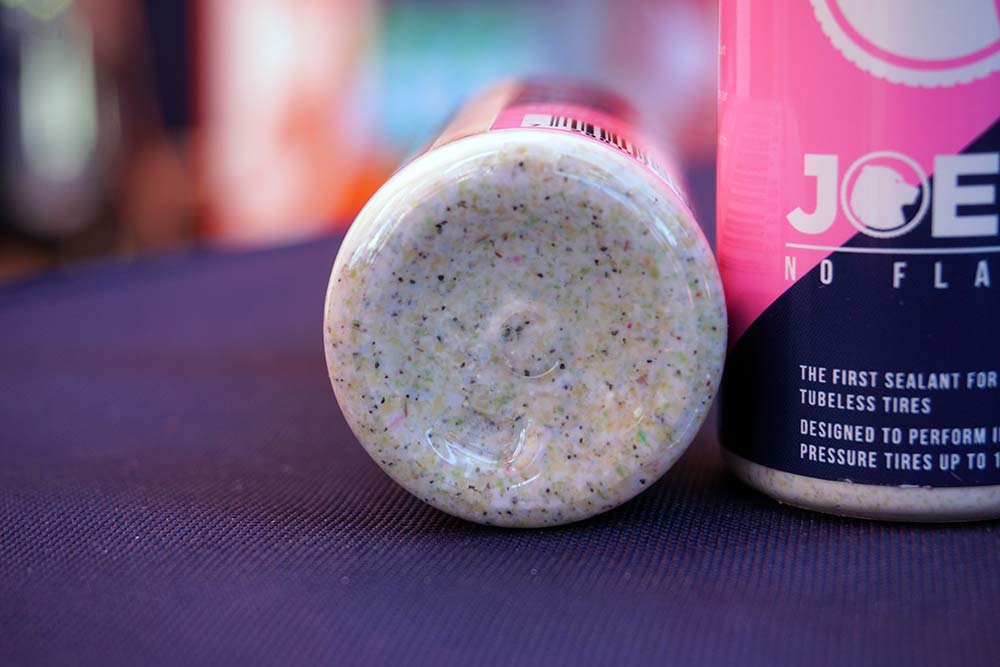
The second aspect relates to the tire sealant itself. When we develop a new sealant, we choose raw materials that will not harm the user, animals and the environment. Most of our raw materials are biodegradable and won’t cause any harm, after all, we are outdoor riders as well and appreciate the nature spots we ride in.
Muc-Off: The Muc-Off No Puncture Hassle Tubeless Sealant is eco-friendly and non-toxic or hazardous and the liquid ingredients are readily biodegradable. We had a carbon footprint test commissioned by Intertek which shows that it’s carbon positive vs. using inner tubes.
Using our sealant makes tires last longer and removes the waste caused by inner tubes – check out the full report here! Our sealant is also super easy to clean out of the tire after use so you can recycle the tire too. This is often not the case when other sealants have been used and have coated and bedded into the inside of the tire.
What particles/fibers/glitter do you use in your sealant? How long do they take to biodegrade and in what conditions?
Stan’s No Tubes: We don’t use any glitter in our sealant, and we don’t recommend adding it. Most glitter is made out of plastic and is definitely not something you want to be leaving on the road or trail after a puncture.
Our particulate mix is a proprietary trade secret but we can say the vast majority is biodegradable. The remainder is made up of natural and sustainable products but can’t be termed “biodegradable”, sort of like how one might say rocks aren’t biodegradable.
Joe’s No Flats: We have never used “glitter-like” particles for our products, although it is very cheap. For solid particles we are using natural origin materials, recycled materials and by-products.
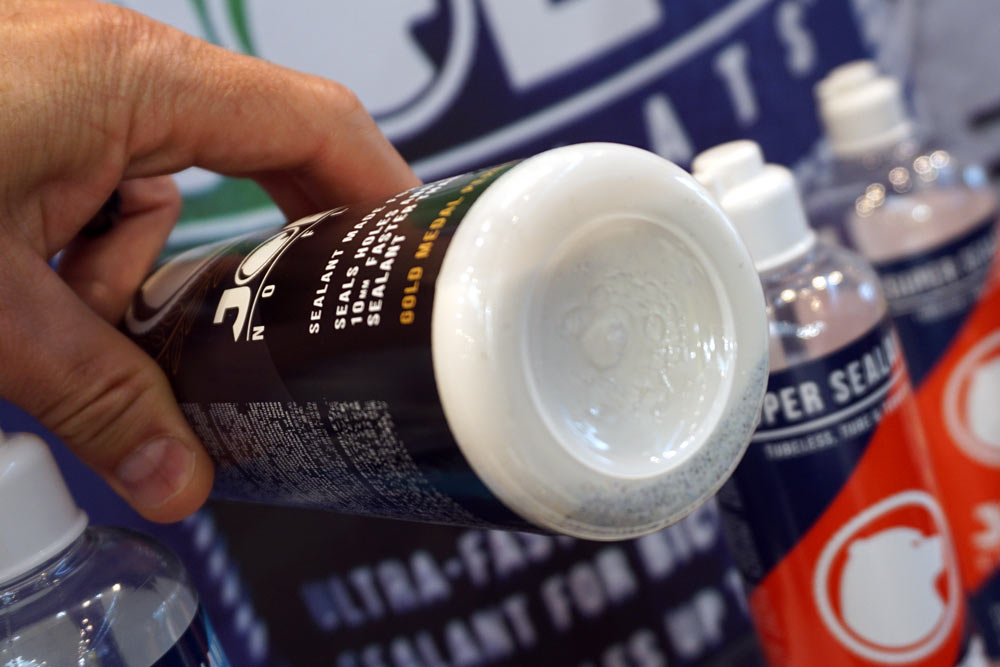
Usually, a material is biodegradable if it has been tested in specific conditions (like temperature, moisture, bacteria, time, etc.). Testing biodegradability is not easy since it is a very long test (6 months) and needs to be done in special labs.
Peaty’s: The platelets used in our sealant are ISO 14851 accredited Bio-glitter made from a special form of cellulose from hardwoods, primarily eucalyptus, sourced from responsibly managed and certified plantations operating to PEF™ (www.pefc.org) standards. You can read much more about it, and the ISO accreditation here.
Just how long it takes to degrade would be no different to a piece of tree bark of the same size. The length of time is highly dependent on the climate – heat/water/oxygen – and how biologically ‘competitive’ that environment is as microorganisms are needed to start the degrading process. In natural conditions, you could expect the glitter to degrade in around 4 weeks.
Muc-Off: Our Tubeless sealant doesn’t contain any glitter-like particles. Instead we use recycled tire particles in the liquid to aid with sealing but this is not classed as biodegradable.
We believe that up-cycling used tires extends the lifespan of this material, diverting it from going straight to landfill by making new products from it and increasing environmental value.
What’s the maximum hole size your tubless sealant will seal?
Stan’s No Tubes: Our standard sealant will seal a puncture up to 6mm in size. With more sealing crystals, and larger XL crystals, race sealant will seal 6mm+ cuts quicker, but is not considered a replacement for daily use. For very large cuts that the sealant isn’t able to seal, we recommend using our DART tool to repair the tire.
Peaty’s: 6mm… The stabber Peaty uses in the attached video is 5mm and these sealed no problem!
Joe’s No Flats: In most cases, any hole up to about 6mm will be totally sealed. Our Podium sealant can show much better performance and in some tires it can seal holes and cuts up to 1cm across.
Muc-Off: Our sealant seals holes of up to 6mm!
Will your tire sealant work if mixed with another brand’s sealant?
Stan’s No Tubes: That is not something we have tested thoroughly. Any time you are mixing different chemicals, things can go wrong quickly. So to stay on the safe side, we always recommend cleaning out your tire before changing to a different brand of sealant.
Peaty’s: Due to the aggressive nature of ammonia in other sealants, and that we simply don’t know exactly what chemicals are used by other sealant brands, we highly recommend washing out your tire of any other sealant and starting fresh.
Joe’s No Flats: Some sealants are similar in composition. It is hard to tell or monitor what other manufacturers are doing. For maximum performance, we totally recommend using one type of sealant in the tire.
From a user point of view, we make sure that most of our sealants can be mixed together if the rider needs to do so.
Muc-Off: No, we wouldn’t suggest mixing our tubeless sealant with another one. Mixing sealants could result in an unwanted chemical reaction leading to the sealant potentially losing its sealing properties.
Is your tire sealant compatible with tire inserts?
Stan’s No Tubes: Yes, our sealant is compatible with tire inserts. Porous or open-cell inserts may absorb sealant, so you may have to refresh more often, but using tire inserts are fine with our rims, wheels, and sealant.
Peaty’s: Yes, we’ve had World Cup Downhill and EWS riders racing with all sorts of insert combinations over the years with no issues.
Joe’s No Flats: Yes, we tested most inserts, didn’t have any complaints about the others.
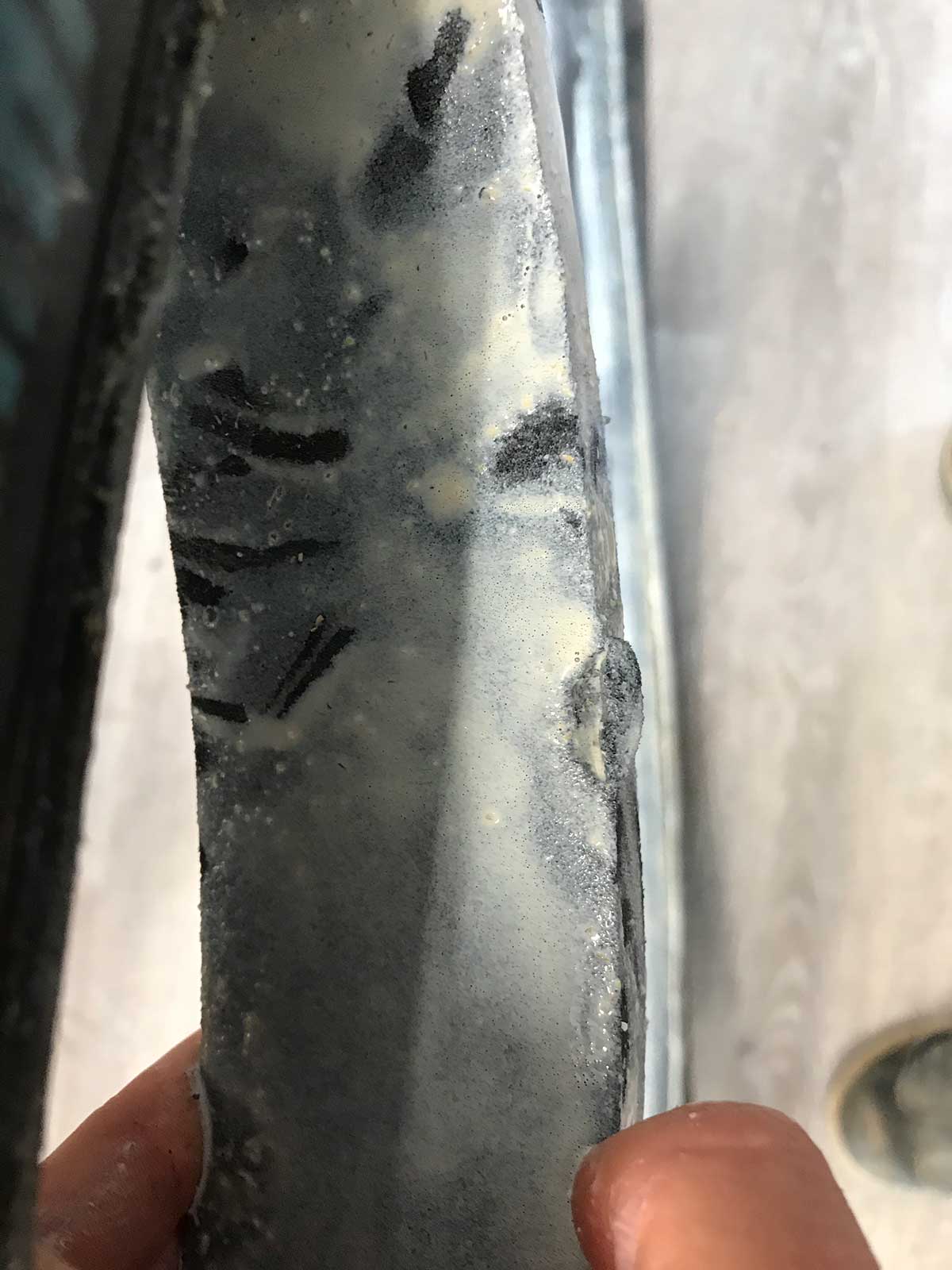
Muc-Off: Yes, it is generally compatible but we’d always recommend checking with the insert manufacturer on their insert/sealant suggestions.
How much Muc-Off tube sealant would you use in a Brompton 16″ inner tube like a Schwalbe AV4?
Muc-Off: There is a handy guide on the side of our inner tube sealant bottles. 50ml of inner tube sealant should be used for wheels up to 18”.
Thank you to Gilad Yarkoni, Bryn Morgan from Peaty’s, Drew Esherick from Stan’s No Tubes and Hollie Weatherstone from Muc-Off for contributing to this week’s “Ask A Stupid Question”.
Got a question of your own? Click here to use the AASQ form to submit questions on any cycling-related topic of your choice, and we’ll get the experts to answer them for you!

